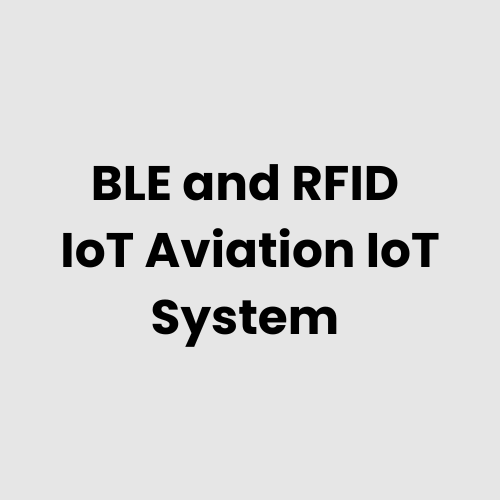Description
Technical Architecture of BLE and RFID IoT Enabled Aviation IoT System
GAO Tek Inc.’s BLE and RFID IoT Enabled Aviation IoT System integrates advanced sensors, RFID readers, BLE beacons, and a robust network to streamline aviation operations. The architecture is tiered, consisting of edge devices for data collection, gateways for data aggregation, and cloud or local servers for processing. The system incorporates real-time tracking, data analytics, and automation, ensuring efficient baggage handling, aircraft maintenance, and passenger services.
List of Hardware of BLE and RFID IoT Enabled Aviation IoT System
- RFID Readers and Tags: For baggage tracking and inventory management.
- BLE Beacons: To provide real-time location-based information and passenger navigation.
- IoT Gateways: For secure data transfer between edge devices and servers.
- Wireless Access Points: Ensures reliable network connectivity within terminals.
- Environmental Sensors: For monitoring temperature, humidity, and other critical parameters.
- Mobile Scanners: For handheld scanning of RFID tags and BLE signals.
- Edge Computing Devices: For processing data locally at airports.
- Local Servers and Cloud Integration Modules: For scalable and secure data storage and analytics.
Physical Placement Considerations of Hardware
- RFID Readers and BLE Beacons:
a. Installed at strategic locations such as baggage claim areas, gates, and terminals.
b. Placed in secure yet accessible locations for easy maintenance.
- IoT Gateways:
a. Positioned at key nodes to ensure optimal data transmission across the network.
- Environmental Sensors:
a. Installed in cargo holds and sensitive areas to monitor environmental conditions.
- Wireless Access Points:
a. Distributed throughout the airport for seamless network coverage.
- Local Servers:
a. Housed in secure data centers within the airport premises for easy accessibility and compliance.
Hardware Architecture of BLE and RFID IoT Enabled Aviation IoT System
The hardware architecture includes:
- Edge Layer: RFID readers, BLE beacons, and environmental sensors for data acquisition.
- Network Layer: IoT gateways and wireless networks for secure data routing.
- Processing Layer: Edge computing devices and local servers for real-time processing.
- Cloud Integration Layer: Cloud-based analytics and storage for long-term insights and scalability.
Deployment Considerations
- Scalability: Ensure the system can handle peak traffic and expanding airport operations.
- Interoperability: Integration with existing aviation systems like baggage handling and flight scheduling.
- Data Security: Adhere to stringent cybersecurity protocols to protect sensitive passenger and operational data.
- Reliability: Use redundant hardware to ensure zero downtime in critical operations.
- Compliance: Align deployment with aviation standards and regulations.
List of Relevant Industry Standards and Regulations
- ISO 18000-6C (RFID Standards)
- ISO 22301 (Business Continuity Management)
- ICAO Annex 17 (Security)
- FAA Advisory Circulars
- IATA Resolution 753 (Baggage Tracking)
- GDPR (General Data Protection Regulation)
- ANSI/TIA-568 (Structured Cabling)
- IEEE 802.11 (Wireless Networking)
- Bluetooth Core Specification
Local Server Version
GAO Tek’s local server implementation for the BLE and RFID IoT Enabled Aviation IoT System ensures high data processing speed, low latency, and compliance with regional regulations. The system operates within the airport’s premises, featuring real-time data processing, local storage for critical operations, and integration with airport management systems. It is ideal for airports seeking data sovereignty and high reliability.
GAO Case Studies of BLE and RFID IoT Enabled Aviation IoT System
Case Studies in the USA
- Los Angeles, CA:
BLE and RFID systems were implemented at an international airport to optimize baggage tracking and improve passenger flow. Real-time location tracking enhanced the accuracy of baggage handling and reduced delays. GAO Tek’s expertise ensured seamless integration with existing infrastructure.
- Dallas, TX:
An IoT-enabled system transformed cargo operations at a major hub. BLE beacons monitored cargo containers, providing real-time updates on location and environmental conditions, ensuring compliance with strict aviation standards as outlined by the FAA.
- Atlanta, GA:
The implementation of RFID readers in boarding areas allowed efficient tracking of passengers and boarding passes. This system improved boarding efficiency, reducing delays during peak hours.
- Chicago, IL:
Environmental sensors were deployed to monitor temperature-sensitive goods. Real-time alerts ensured proper handling of pharmaceutical shipments, meeting guidelines from the International Air Transport Association (IATA).
- Denver, CO:
A BLE-enabled navigation system was introduced to guide passengers within a sprawling terminal. The system reduced missed connections and improved customer satisfaction through real-time assistance.
- Seattle, WA:
RFID tagging was used to automate the management of ground service equipment. This reduced instances of misplaced equipment and improved maintenance scheduling in line with recommendations from the Airports Council International (ACI).
- Miami, FL:
A BLE system for passenger tracking was deployed to monitor wait times at security checkpoints. The data helped optimize staffing and reduced passenger frustration.
- Boston, MA:
RFID systems streamlined aircraft maintenance by tracking tools and parts in real time. The solution minimized downtime and improved operational efficiency.
- Orlando, FL:
BLE beacons were used to track VIP passenger services, ensuring a seamless and personalized experience for high-value travelers.
- San Francisco, CA:
IoT-enabled luggage systems reduced mishandled baggage incidents. GAO Tek supported integration with the airport’s baggage handling software for real-time visibility.
- New York, NY:
RFID systems enhanced security by tracking access to restricted zones. The system logged all entries and exits, ensuring compliance with strict aviation regulations set by the Transportation Security Administration (TSA).
- Houston, TX:
BLE solutions were deployed to monitor ground crew activities. The data collected helped optimize shift schedules and improved ground operation efficiency.
- Phoenix, AZ:
An RFID solution improved inventory management of airport retail outlets. Real-time updates ensured that stores were always stocked with high-demand items.
- Las Vegas, NV:
BLE sensors monitored passenger congestion during large events. The system provided actionable insights to redirect passenger flow and reduce bottlenecks.
- Philadelphia, PA:
RFID readers were installed in cargo areas to track high-value shipments. The system provided enhanced security and reduced incidences of misplaced cargo.
Case Studies in Canada
- Toronto, ON:
A major international airport integrated RFID readers into its baggage handling system. The solution improved tracking accuracy and reduced lost baggage claims during peak travel seasons, adhering to Transport Canada standards.
- Vancouver, BC:
BLE beacons were deployed across terminals to guide passengers and monitor their movement. The data helped enhance terminal layouts for improved efficiency and passenger comfort, aligning with Canada’s National Airports Policy.
GAO Tek Inc., headquartered in New York City and Toronto, brings cutting-edge BLE and RFID solutions to aviation facilities across North America. Our advanced systems improve operational efficiency, ensure regulatory compliance, and provide reliable support for evolving aviation needs.
Navigation Menu for BLE and RFID IoT:
- BLE Gateways, Beacons & Accessories
- UHF RFID Readers, Tags & Accessories
- NFC & HF RFID Readers, Tags & Accessories
- LF RFID Readers, Tags & Accessories
- BLE & RFID – Cloud, Server, PC & Mobile Systems
- BLE & RFID Resources
Navigation Menu for IoT
Our products are in stock and can be shipped anywhere in the continental U.S. or Canada from our local warehouse. For any further information, please fill out this form or email us.
We are actively looking for partners who are like us located in the U.S. and Canada. For more information on partnering with GAO, please visit Partner with GAO Tek Inc. It lists various ways to partner with GAO, such as OEM Partnerships, Technology Integration, Distribution and Reselling Opportunities, Presenting at the Leading Event Tek Summit, Joint R&D Projects, Training and Consulting Services, Industry-Specific Collaborations, Research and Academic Partnerships.


